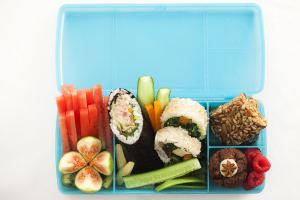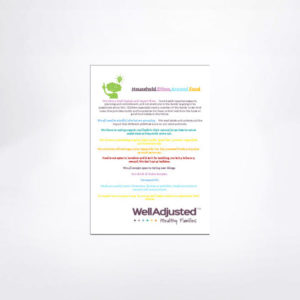 Parents often ask me, “How do I get my children to eat good foods?” and to this I always reply, “Pick your battles and be very clear that ‘food’ is the battle that you win!”
Parents often ask me, “How do I get my children to eat good foods?” and to this I always reply, “Pick your battles and be very clear that ‘food’ is the battle that you win!”
Every family must negotiate guidelines and boundaries around many lifestyle habits but in my experience there are no boundaries as important as diet because what your children eat has an ENORMOUS IMPACT on the whole family.
As parents we need to gain knowledge ourselves on which foods nurture the body and which foods tax our health and then we need to empower our children. Give them credit – our children are way smarter then we think.
Build your knowledge, build your conviction.
It is paramount if we wish to raise healthy children that we build our awareness around what constitutes wholesome nutrition. Knowledge creates conviction and we need to have both knowledge and conviction when explaining to our children our rationale behind our food selections.
We need to be discerning in our search for knowledge and we cannot rely on anyone who may have a hidden agenda including the media, the government, and large food corporations who sponsor celebrities and sporting heroes to endorse their brands.
I’m no different from any other parent who is passionate about important health topics. I question everyone and everything, I search out multiple resources and I read and read. I’m like you because fewer things matter more to me than the health and happiness of my children.
Do We Create Fussy Eaters?
Aside from autistic children who often self-limit their diet, children are not typically born fussy eaters. It is the first few years of a child’s life that establishes most of their dietary habits. This is good to know particularly if you find yourself amidst the madness of parenting more than one young child.
Many times a child’s fussy palate develops as a result of weary, fatigued parents who lose their drive to be firm about what their children are allowed or not allowed to eat and how much of any one food (in one serving) is required to be eaten. Parenting is hard work and enrolling our children to “eat well” is even harder.
 The beauty of having being very firm about “healthy eating” when the boys were little has been that without a doubt, they are now delightful and willing ‘healthy food’ connoisseurs. They are also pretty in tune with how cheap ingredients or poor food choices make their bodies feel.
The beauty of having being very firm about “healthy eating” when the boys were little has been that without a doubt, they are now delightful and willing ‘healthy food’ connoisseurs. They are also pretty in tune with how cheap ingredients or poor food choices make their bodies feel.
This is a brief summary of 10 food discussions that we regularly have in our busy household. Well Adjusted Babies and Lunchbox Solutions both expand on these themes.
As a family:
1. We elect a Food Captain and respect them. Good health requires research, planning and commitment, and not everyone in the family is going to be passionate about this. Children especially need a member of the family to set food rules; this provides clarity and boundaries for them, which will form the basis of good food habits in the future. It’s ideal if both parents can be on the same page about this. Without a Food Captain others can unconsciously sabotage the best intentions to be healthy.
2. We all need to mindful of what we are eating. We read labels and understand the impact that different additives have on our mind and body. Up until the boys were about 7 years old I was very strict about “false foods” I educated the boys heavily. Quite honestly it was easy to provide alternatives to cheap and nasty, false foods.
As they have gotten older the pressure has built. The boys want to try the foods their friends are allowed to have, often whenever they like. Now having keenly observed parents who have been incredibly strict and restrictive about junk food, I’ve then observed that at some point their kids burst and they then sneak, hide, lie and gorge the processed foods behind closed doors, under their bed or at their friends house. So yes, education is my go-to-approach but so is moderation.
If the boys want to try a sketchy false food then they need to acknowledge it will tax their body. We typically analyse the item, discuss it, read about it if need be, and if we agree that they can have it, then we talk about what might be good to do for their body after they’ve eaten it. For example they have to have some real food and plenty of water prior to eating the junk item. They also have to agree to go outside or do some exercise afterwards because no doubt the junk item will send them completely loopy.
3. We focus on eating organic, real foods in their natural state as frequently as we can. I have many blogs on how a family can reduce the cost of organic shopping.
4. We focus on prioritising high quality “good fats”, proteins vegetables and fruits. The boys focus on eating at least 4 serves if not more of vegetables a day (a serve is about the size of your palm) and 2-3 serves of fruit. We have a serve of protein in most meals and aim for at least 2 serves of “good fats” a day.
5. We minimise refined sugar, dairy (especially low fat), processed foods and grains as much as we can.
6. Food is not eaten in boredom and it isn’t for soothing, nor is it a bribe or a reward. We don’t eat at bedtime.
7. We all remain open to trying new things. Kids eat what adults eat — no short order cooking. All foods need to be tried and explored.
8. Our drink of choice is water. Commercial juice is consumed sometimes, soft drinks on very rare occasions and cola or any other caffeinated, ‘hyped-up’ drink is for those that have finished growing.
9. No means NO. Pure and simple.
10. Meals are a social event – we eat together, free from distractions, creating a time to connect and communicate.
And okay …..one more for good measure.
11. No matter how young we may be, we can still be a health guru and inspire others to make better food choices.

For ease we have created a printable PDF summary of the above points that you can put on the fridge.
To read more on Jen’s thoughts on Paleo and healthy eating please see “Paleo for Kids”
. . . . .
Wishing you and yours exceptional health
Jennifer




